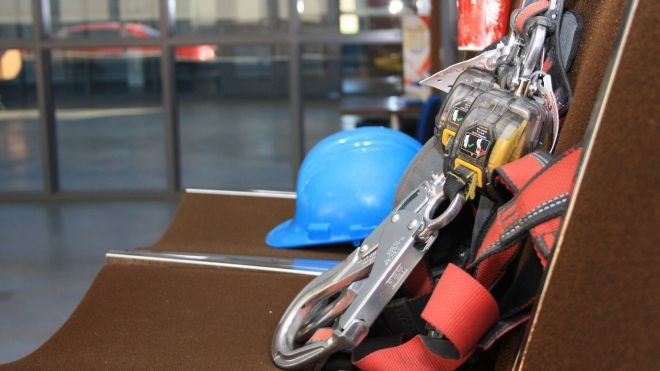It’s almost two months into the opening of the new Carpenters’ Union Local 1669 Training Centre and all is going well, said Bruce Kruger, the facility’s training coordinator.
“It’s nice to have the big space, compared to where we were,” said Kruger. “It was challenging to have 12 participants in one room – very restricted.”
Originally, the Carpenters’ Union rented training space at the now-demolished Lakehead Labour Centre before moving to a temporary building. Their new building in Innova Business Park in Thunder Bay opened in September. The custom-built facility is well-ventilated with room for practical and classroom learning, providing skills and safety training for its membership as well as the public. Classes available right now include working at heights and WHMIS safety training, which are required courses for anyone in construction and related trades.
“Before you go on a construction site, whether you’re union or non-union, you need specific training,” Kruger said.
Sometimes that training needs to be upgraded as well. For example, people working at heights in construction, roofing, and other industries will need to meet new training standards. “Anybody that has had old fall arrest training prior to April 1, 2014, they’ll need to have this new one by April 1, 2017,” Kruger said.
The training centre will also offer other trade-specific classes and apprenticeship programs including some only offered to Local 1669 union members. In the near term, the centre plans to offer a power-elevated work platforms program and the Infrastructure Health and Safety Association’s (ISHA) suspended access training program (which would be the only one of its kind offered in Northwestern Ontario), and has put in an application to become a Red Seal drywall apprenticeship program.
Right now, the closest similar course is in Sudbury, which requires participants to move there for the eight-week course. Bringing that program closer to home would obviously be a benefit to the regional workforce.
Long-term, other programs are being considered including a hands-on and virtual welding program, a practical pile-driving course, and skills training geared to students just coming out of high school. The facility is flexible enough to adapt to almost any related training program.
“There’s a lot of potential and a lot of unforeseen potential – it plants seeds and ideas in organizations,” Kruger said.
Kruger said that the training facility is legally separate from the Carpenters’ Union with its own board of directors, though the union is its main tenant. The Carpenters’ Local Union 1669 started an Apprenticeship and Carpentry Industry Promotion Trust Fund to train to develop the skills of its members from White River, Ont. west to the Manitoba border and points north. The Northern Ontario Heritage Fund Corporation (NOHFC) helped fund the construction of the training centre with a $1 million grant.
Other unions and organizations can rent the space for practical training, classroom training (the facility has two classrooms that comfortably fit 25 students each, and can open up to make one big room), and an executive board room suitable for meetings or another training space.
“Everybody talks about the predicted shortage of people in the trades,” said Wayne Sohlman, president of the training centre. The facility can help by providing
apprenticeship training for carpenters and by providing general safety and other courses to related trades. “This is a great venue to bring in the public. We are all part of the building trades.”
Sohlman said that they have also partnered with First Nation organizations in the region such as Sioux Lookout Area Aboriginal Management Board (SLAAMB) and Kiikenomaga Kikenjigewen Employment & Training Services (KKETS) to provide training.
The training centre represents almost limitless training possibilities.
“The important thing is that we’ve got the building done and we’re in it, and now we are going to figure out how to make it work,” Sohlman said.




